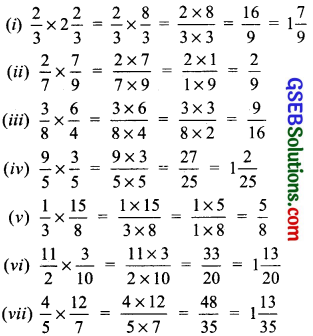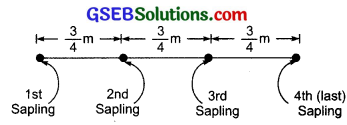Gujarat Board GSEB Textbook Solutions Class 7 Maths Chapter 2 Fractions and Decimals Ex 2.3 Textbook Questions and Answers.
Gujarat Board Textbook Solutions Class 7 Maths Chapter 2 Fractions and Decimals Ex 2.3
![]()
Question 1.
Find (i) \(\frac { 1 }{ 4 }\) of (a) \(\frac { 1 }{ 4 }\) (b) \(\frac { 3 }{ 4 }\) (c) \(\frac { 4 }{ 3 }\)
(ii) \(\frac { 1 }{ 7 }\) of (a) \(\frac { 2 }{ 9 }\) (b) \(\frac { 6 }{ 5 }\) (c) \(\frac { 3 }{ 10 }\)
Solution:
(i) (a) \(\frac { 1 }{ 4 }\) of \(\frac { 1 }{ 4 }\)
= \(\frac { 1 }{ 4 }\) x \(\frac { 1 }{ 4 }\)
= \(\frac { 1 ×1 }{ 4×4 }\) = \(\frac { 1 }{ 16 }\)
(b) \(\frac { 1 }{ 4 }\) of \(\frac { 3 }{ 5 }\)
= \(\frac { 1 }{ 4 }\) x \(\frac { 3 }{ 5 }\)
= \(\frac { 1 ×3 }{ 4×5 }\) = \(\frac { 3 }{ 20 }\)
(c) \(\frac { 1 }{ 4 }\) of \(\frac { 4 }{ 3 }\)
= \(\frac { 1 }{ 4 }\) x \(\frac { 4 }{ 3 }\)
= \(\frac { 1 ×4 }{ 4×3 }\) = \(\frac { 1 }{ 3 }\)
(ii) (a) \(\frac { 1 }{ 7 }\) of \(\frac { 2 }{ 9 }\)
= \(\frac { 1 }{ 7 }\) x \(\frac { 2 }{ 9 }\)
= \(\frac { 1 ×2 }{ 7×9 }\) = \(\frac { 2 }{ 63 }\)
(b) \(\frac { 1 }{ 7 }\) of \(\frac { 6 }{ 5 }\)
= \(\frac { 1 }{ 7 }\) x \(\frac { 6 }{ 5 }\)
= \(\frac { 1 ×6 }{ 7×5 }\) = \(\frac { 6 }{ 35 }\)
(c) \(\frac { 1 }{ 7 }\) of \(\frac { 3 }{ 10 }\)
= \(\frac { 1 }{ 7 }\) x \(\frac { 3 }{ 10 }\)
= \(\frac { 1 ×3 }{ 7×10 }\) = \(\frac { 3 }{ 70 }\)
![]()
Question 2.
Multiply and reduce to lowest form (if possible):
(i) \(\frac { 2 }{ 3 }\) x 2\(\frac { 2 }{ 3 }\)
(ii) \(\frac { 2 }{ 7 }\) x \(\frac { 7 }{ 9 }\)
(iii) \(\frac { 3 }{ 8 }\) x \(\frac { 6 }{ 4 }\)
(iv) \(\frac { 9 }{ 5 }\) x \(\frac { 3 }{ 5 }\)
(v) \(\frac { 1 }{ 3 }\) x \(\frac { 15 }{ 8 }\)
(vi) \(\frac { 11 }{ 2 }\) x \(\frac { 3 }{ 10 }\)
(vii) \(\frac { 4 }{ 5 }\) x \(\frac { 12 }{ 7 }\)
Solution:

Question 3.
Multiply and reduce to lowest form and convert into a mixed fraction:
(i) \(\frac { 2 }{ 5 }\) x 5\(\frac { 1 }{ 4 }\)
(ii) 6\(\frac { 2 }{ 5 }\) x \(\frac { 7}{ 9 }\)
(iii) \(\frac { 3 }{ 2 }\) x 5\(\frac { 1 }{ 3 }\)
(iv) \(\frac { 5 }{ 6 }\) x 2\(\frac { 3 }{ 7 }\)
(v) 3\(\frac { 2 }{ 5 }\) x 4\(\frac { 4 }{ 7 }\)
(vi) 2\(\frac { 3 }{ 5 }\) x 3
(vii) 3\(\frac { 4 }{ 7 }\) x \(\frac { 3 }{ 5 }\)
Solution:

Question 4.
Which is greater:
(i) \(\frac { 2 }{ 7 }\) of \(\frac { 3 }{ 4 }\) or \(\frac { 3 }{ 5 }\) of \(\frac { 5 }{ 8 }\)?
(ii) \(\frac { 1 }{ 2 }\) of \(\frac { 6 }{ 7 }\) or \(\frac { 2 }{ 3 }\) of \(\frac { 3 }{ 7 }\)?
Solution:
(i) Comparing \(\frac { 2 }{ 7 }\) of \(\frac { 3 }{ 4 }\) and \(\frac { 3 }{ 5 }\) of \(\frac { 5 }{ 8 }\)
∵ \(\frac { 2 }{ 7 }\) of \(\frac { 3 }{ 4 }\)
= \(\frac { 2 }{ 7 }\) x \(\frac { 3 }{ 4 }\)
= \(\frac { 1×3 }{ 7×2 }\)
= \(\frac { 3 }{ 14 }\)
and \(\frac { 3 }{ 5 }\) of \(\frac { 5 }{ 8 }\)
= \(\frac { 3 }{ 5 }\) x \(\frac { 5 }{ 8 }\)
= \(\frac { 3×1 }{ 1×8 }\)
= \(\frac { 3 }{ 8 }\)
Again \(\frac { 3 }{ 14 }\) = \(\frac { 3×4 }{ 14×4 }\)
= \(\frac { 12 }{ 56 }\) [∵ LCM of 14 and 8 is 56]
= \(\frac { 3 }{ 8 }\) = \(\frac { 3×7 }{ 8×7 }\) = \(\frac { 21 }{ 56 }\)
Now, \(\frac { 21 }{ 56 }\) > \(\frac { 12 }{ 56 }\)
∴ \(\frac { 3 }{ 5 }\) of \(\frac { 5 }{ 8 }\) is greater than \(\frac { 2 }{ 7 }\) of \(\frac { 3 }{ 4 }\).
(ii) Comparing \(\frac { 1 }{ 2 }\) of \(\frac { 6 }{ 7 }\) or \(\frac { 2 }{ 3 }\) of \(\frac { 3 }{ 7 }\):
∵ \(\frac { 1 }{ 2 }\) of \(\frac { 6 }{ 7 }\) = \(\frac { 1 }{ 2 }\) x \(\frac { 6 }{ 7 }\)
= \(\frac { 1×3 }{ 1×7 }\) = \(\frac { 3 }{ 7 }\)
and, \(\frac { 2 }{ 3 }\) of \(\frac { 3 }{ 7 }\)
= \(\frac { 2 }{ 3 }\) x \(\frac { 3 }{ 7 }\)
= \(\frac { 2×1 }{ 1×7 }\) = \(\frac { 2 }{ 7 }\)
Also 3 > 2 ⇒ \(\frac { 3 }{ 7 }\) > \(\frac { 2 }{ 7 }\)
∴ \(\frac { 1 }{ 2 }\) of \(\frac { 6 }{ 7 }\) is greater than \(\frac { 2 }{ 3 }\) of \(\frac { 3 }{ 7 }\)
![]()
Question 5.
Saili plants 4 saplings, in a row, in her garden. The distance between two adjacent saplings is \(\frac { 3 }{ 4 }\) m. Find the distance between the first and the last sapling.
Solution:

Number of saplings = 4
Distance between two adjacent saplings = \(\frac { 3 }{ 4 }\)m
∴ Distance between 1st and last (4th) sapling , 3
= 3 x \(\frac { 3 }{ 4 }\)m
= \(\frac { 3×3 }{ 4 }\)m
= \(\frac { 9 }{ 4 }\)m
= 2\(\frac { 1 }{ 4 }\)m
Question 6.
Lipika reads a book for 1\(\frac { 3 }{ 4 }\) hours everyday. She reads the entire book in 6 days. How many hours in all were required by her to read the book?
Solution:
Number of days = 6
Reading hours per day (for one day) = 1\(\frac { 3 }{ 4 }\) hours
∴ Total number of reading hours
= 6 x 1\(\frac { 3 }{ 4 }\)
= 6 x \(\frac { 7 }{ 4 }\) hours
= \(\frac { 3×7 }{ 2 }\) hours = \(\frac { 21 }{ 2 }\) hours = 10\(\frac { 1 }{ 2 }\) hours
![]()
Question 7.
A car runs 16 km using 1 litre of petrol. How much distance will it cover using 2\(\frac { 3 }{ 4 }\) litres of petrol.
Solution:
Distance covered in 1 litre of petrol =16 km
∴ Distance covered in 2\(\frac { 3 }{ 4 }\) litres of petrol
= 16 x 2\(\frac { 3 }{ 4 }\) km
= 16 x \(\frac { 11 }{ 4 }\) km
= \(\frac { 16×11 }{ 4 }\) km
= \(\frac { 4×11 }{ 1 }\) km
= 44 km
Question 8.
(a)
(i) Provide the number in the box ![]() , such that \(\frac { 2 }{ 3 }\) x
, such that \(\frac { 2 }{ 3 }\) x ![]() = \(\frac { 10 }{ 30 }\).
= \(\frac { 10 }{ 30 }\).
(ii) The simplest form of the number obtained in ![]() is ______.
is ______.
(b)
(i) Provide the number in the box ![]() , such that \(\frac { 3 }{ 5 }\) x
, such that \(\frac { 3 }{ 5 }\) x ![]() = \(\frac { 24 }{ 75 }\).
= \(\frac { 24 }{ 75 }\).
(ii) The simplest form of the number obtained in ![]() is ______.
is ______.
Solution:
(a)
(i) We have: \(\frac { 2 }{ 3 }\) x \(\frac { 5 }{ 10 }\) = \(\frac { 10 }{ 30 }\) , i.e. the required number = \(\frac { 5 }{ 10 }\)
(ii) Simplest form of 
(b)
(i) We have: \(\frac { 3 }{ 5 }\) x \(\frac { 8 }{ 15 }\)
= \(\frac { 24 }{ 75 }\), i.e. the required number = \(\frac { 8 }{ 15 }\)
(ii) The simplest form of \(\frac { 8 }{ 15 }\) is \(\frac { 8 }{ 15 }\).